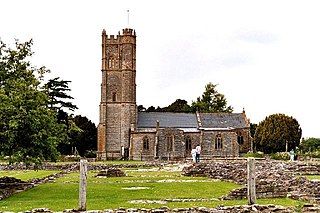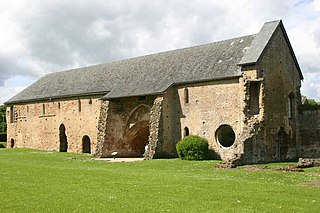
The Abbey Church of Waltham Holy Cross and St Lawrence, also known as Waltham Abbey, is the parish church of the town of Waltham Abbey, Essex, England. It has been a place of worship since the 7th century. The present building dates mainly from the early 12th century and is an example of Norman architecture. To the east of the existing church are traces of an enormous eastward enlargement of the building, begun following the re-foundation of the abbey in 1177. In the Late Middle Ages, Waltham was one of the largest church buildings in England and a major site of pilgrimage; in 1540 it was the last religious community to be closed during the Dissolution of the Monasteries. It is still an active parish church for the town.

Netley Abbey is a ruined late medieval monastery in the village of Netley near Southampton in Hampshire, England. The abbey was founded in 1239 as a house for monks of the austere Cistercian order. Despite royal patronage, Netley was never rich, produced no influential scholars nor churchmen, and its nearly 300-year history was quiet. The monks were best known to their neighbours for the generous hospitality they offered to travellers on land and sea.

The Hospital of St John the Baptist was a hospital in High Wycombe in Buckinghamshire, England between 1180 and 1548. It was situated on the main road that ran from Oxford to London east of the town centre.

The Abbey of St Mary is a ruined Benedictine abbey in York, England and a scheduled monument.

Beeleigh Abbey near Maldon in Essex, England, was a monastery constructed in 1180 for the Order of Canons Regular of Prémontré, as known as the Norbertines or Premonstratensians. The order linked the change of the separate life of monks in the 12th century with the retrospective life of the friar, who was considerably more active.

Muchelney Abbey is an English Heritage property in the village of Muchelney in the Somerset Levels, England. The site consists of ruined walls showing the layout of the abbey buildings constructed from the 7th to 16th centuries, and the remaining intact Abbot's House. It is next to the parish church in which some of the fabric of the abbey has been reused.

Cleeve Abbey is a medieval monastery located near the village of Washford, in Somerset, England. It is a Grade I listed building and has been scheduled as an ancient monument.

Isleham Priory Church, located in Isleham, Cambridgeshire, England, is a Benedictine alien priory built around 1100 AD. It is an important example of an early 12th century Norman church. Despite being converted into a barn after the Reformation, the building remains mostly in its original state. The church is designated a Grade I listed building. The structure and surrounding area are also designated a scheduled Ancient Monument.

Colchester in Essex, England, has a number of notable churches.

Calcot Manor is a historic building in Calcot, three and a half miles west of Tetbury on A 4135 in Gloucestershire, England, near the junction of roads A46 and A4135. The original building was established in approximately 1300 AD by Henry of Kingswood as a tithe barn annex of Kingswood Abbey. The estate was expanded to include a 16th-century manor house and other buildings. Structures added from the Late Middle Ages to the mid-17th century include a chapel, granary, stables and other buildings. The buildings are all constructed from limestone; which are locally quarried stones that are typically flat and easily stacked for drystone wall purposes.

St John's Abbey, also called Colchester Abbey, was a Benedictine monastic institution in Colchester, Essex, founded in 1095. It was dissolved in 1539. Most of the abbey buildings were subsequently demolished to construct a large private house on the site, which was itself destroyed in fighting during the 1648 siege of Colchester. The only substantial remnant is the elaborate gatehouse, while the foundations of the abbey church were only rediscovered in 2010.

St John the Baptist's Church is the former cathedral of Chester, Cheshire, England during the Early Middle Ages. The church, which was first founded in the late 7th Century by the Anglo Saxons, is outside Chester's city walls on a cliff above the north bank of the River Dee. It is now considered to be the best example of 11th–12th century church architecture in Cheshire, and was once the seat of the Bishop of Lichfield from 1075 to 1095.

Stoke sub Hamdon Priory is a complex of buildings and ruins which initially formed a 14th-century college for the chantry chapel of St Nicholas, and later was the site of a farm in Stoke-sub-Hamdon, Somerset, England. The only building remaining from the college is a great hall and attached dwelling, dating from the late 15th century. The hall is designated by English Heritage as a Grade I listed building, while the outbuildings and gateway are Grade II listed. The whole site has been scheduled as an ancient monument. A number of the farm buildings are in poor condition, and have been added to the Heritage at Risk Register.

The Hospital of St Lawrence, variously known as St Lawrence's Hospital, the Hospice of St Lawrence and the free Chapel and Hospice of St Lawrence and St James, was a medieval house for lepers outside the town of Nantwich, Cheshire, England. It was located to the west of the town, on what is now Welsh Row, within the parish of Acton. St Lawrence's later became a hospital for the infirm poor. Dissolved in 1548, the hospital's land and property was purchased by the Wright family. One of its buildings was subsequently used for dwellings.
Eye Priory was a Benedictine Priory dedicated to St Peter in the town of Eye in the English county of Suffolk. It was founded by Robert Malet c. 1080 and originally an Alien Priory dependent on Bernay Abbey in Normandy. It became independent in 1385 by charter of Richard II when it could support only 3-4 monks. It was finally dissolved in 1537 as part of the Dissolution of the Monasteries, with the lands being given to Charles Brandon, 1st Duke of Suffolk.

The Hospital Chapel of St Mary the Virgin and St Thomas of Canterbury, Ilford, also known as Ilford Hospital Chapel is on Ilford Hill in Ilford. It is an ancient charitable foundation dating from about 1140, and is the oldest building in the London Borough of Redbridge. Since 1954 it has been protected as a Grade II* listed building under UK legislation.

The Hospital of St Mary Magdalene is a former Catholic religious complex in Glastonbury, Somerset, England. It built around 1310 by the Benedictine monks of Glastonbury Abbey. The hospital is a Grade II* listed building, and a portion has been scheduled as an ancient monument.

Litten Chapel is an early 16th chapel associated with the old medieval hospital of St Bartholomew in Newbury, Berkshire, England. The single storey chapel contains a set of carved timber roof trusses that are a notable example of post-medieval craftsmanship. The structure is a Grade II* listed building and a scheduled monument under the care of English Heritage.
There are 121 scheduled monuments in the county of Buckinghamshire, in England. These protected sites date from the Neolithic period in some cases and include barrows, moated sites, ruined abbeys, Iron Age hillforts, a medieval hospital and a holy well. In the United Kingdom, the scheduling of monuments was first initiated to ensure the preservation of "nationally important" archaeological sites or historic buildings. Protection is given to scheduled monuments under the Ancient Monuments and Archaeological Areas Act 1979.
There are 425 scheduled monuments in the county of Essex, England. These protected sites date from the Neolithic period in some cases and include barrows, moated sites, ruined abbeys, castles, and a windmill. In the United Kingdom, the scheduling of monuments was first initiated to ensure the preservation of "nationally important" archaeological sites or historic buildings. Protection given to scheduled monuments under the Ancient Monuments and Archaeological Areas Act 1979.

















